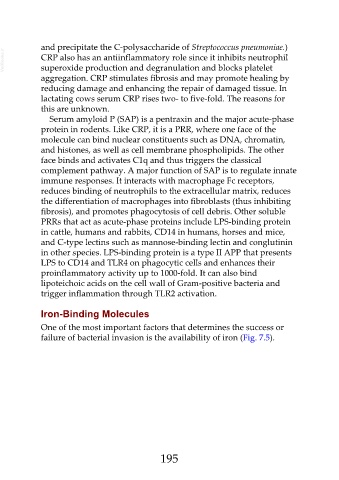Page 195 - Veterinary Immunology, 10th Edition
P. 195
and precipitate the C-polysaccharide of Streptococcus pneumoniae.)
VetBooks.ir CRP also has an antiinflammatory role since it inhibits neutrophil
superoxide production and degranulation and blocks platelet
aggregation. CRP stimulates fibrosis and may promote healing by
reducing damage and enhancing the repair of damaged tissue. In
lactating cows serum CRP rises two- to five-fold. The reasons for
this are unknown.
Serum amyloid P (SAP) is a pentraxin and the major acute-phase
protein in rodents. Like CRP, it is a PRR, where one face of the
molecule can bind nuclear constituents such as DNA, chromatin,
and histones, as well as cell membrane phospholipids. The other
face binds and activates C1q and thus triggers the classical
complement pathway. A major function of SAP is to regulate innate
immune responses. It interacts with macrophage Fc receptors,
reduces binding of neutrophils to the extracellular matrix, reduces
the differentiation of macrophages into fibroblasts (thus inhibiting
fibrosis), and promotes phagocytosis of cell debris. Other soluble
PRRs that act as acute-phase proteins include LPS-binding protein
in cattle, humans and rabbits, CD14 in humans, horses and mice,
and C-type lectins such as mannose-binding lectin and conglutinin
in other species. LPS-binding protein is a type II APP that presents
LPS to CD14 and TLR4 on phagocytic cells and enhances their
proinflammatory activity up to 1000-fold. It can also bind
lipoteichoic acids on the cell wall of Gram-positive bacteria and
trigger inflammation through TLR2 activation.
Iron-Binding Molecules
One of the most important factors that determines the success or
failure of bacterial invasion is the availability of iron (Fig. 7.5).
195

